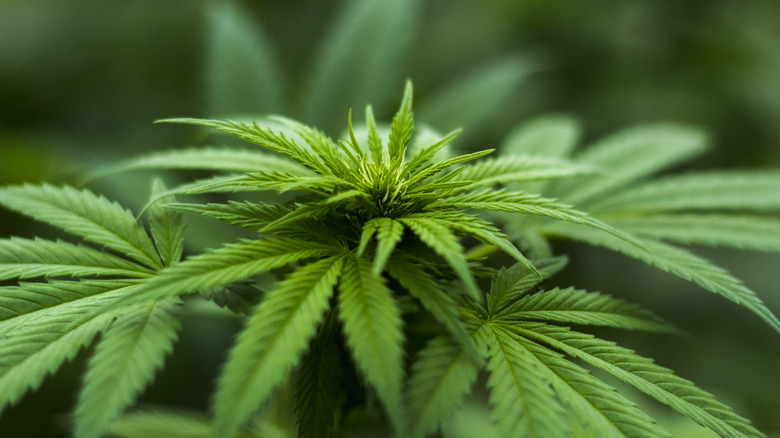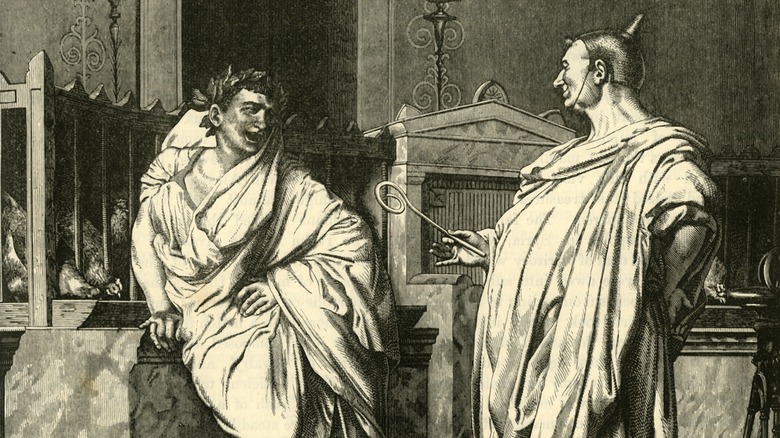How Was Marijuana Used In Ancient Rome?
You know those ancient Romans: making speeches at the forum downtown, subduing less militarily advanced peoples, incorporating a wide variety of ethnic groups into their empire, modifying Greek architecture to construct massive domed structures, and yes, getting blazed on the side. "Say what?" you ask. "I thought the Romans got crunk on that juicy wine junk?" To a degree. By all accounts, Romans preferred cannabis mostly for its practical uses (e.g., making textiles), somewhat for its medical uses, and maybe for its recreational and religious uses.
Rome, of course, was not the only ancient civilization whose people got all red-eyed on the sofa. Wired says folks in ancient China circa 2,500 years ago smoked up at funerals while plucking the harp. Head Magazine talks about Native American uses of the chronic, and the Cherokees saying that the Star People brought the herb with them to Earth. And yes, ancient Greeks inhaled sticky-icky fumes after Scythian nomads brought pot West from the Central Asian steppes, per the Delphi Guide.
Knowledge of cannabis in ancient Rome comes from scattered written sources, not a compendium of sativa strains, per "Cannabis in the Ancient Greek and Roman World." Cannabis was just another material of the natural world. Romans used "cultivated" (non-psychoactive, aka hemp) cannabis to make things like bags and sandals, and "wild" (psychoactive, aka marijuana) cannabis for medical purposes.
Inhaled, strained, and pressed for millennia
We'd best discard cultural and ethical clutter and biases moving forward. As "Cannabis in the Ancient Greek and Roman World" explains, much of what we know about ancient Rome's relationship to cannabis comes from scattered texts. Any cups, bowls, containers, etc., used to house cannabis have been long destroyed and can't be chemically analyzed. And even though cannabis shows up in literature — even dramas — there's not a ton of direct explanation about it because the audience of the time wouldn't have needed such explication. If humans living in 4,000 C.E. uncovered a play from 2023 C.E. containing a scene where a character casually pops a couple of Aspirin, would that character go on a detailed diatribe about Aspirin's function, purpose, creation, chemical composition, pharmacological role, etc.? Didn't think so.
And yet, many aspects of Roman cannabis usage are strangely familiar. The University of Sydney says that the first documented use of marijuana was in 2,800 B.C.E. in China before it traveled through India, the Middle East, Greece, Rome, and more. It was commonly used to treat arthritis, asthma, depression, pain, you name it. By the 1st century, the Romans distinguished between wild (marijuana) and domesticated (hemp) cannabis used for medicine and textiles, respectively. Folks at the time, worldwide, would have pressed cannabis to make poultices, hash, or resin, passed water through it like tea, or thrown the psychoactive strain over heat and inhaled it.
Medical uses: inflammation and pain reduction
Cannabis found its way into Roman society in part through medicine, and much of that medicine through Greece. It's impossible to talk about cannabis in ancient Rome without talking about Greece. Our most methodical and thorough source of information comes from the Greek physician Pedanius Dioscorides, who in 77 C.E. compiled his five-volume tome, "De Materia Medica" ("On Medical Matters"), which catalogs the descriptions and medical applications of 600 herbs, roots, stems, fruits, vines, and animal products in detail. He says that opium and mandragora, for instance, make good anesthetics during surgery.
Dioscorides separates cannabis into "kannabis emeros" and "kannabis agria" — and yes, he says "kannabis" because kannabis is a Greek word. Dioscorides says that kannabis emeros acts as birth control and reduces earaches if eaten. When boiled and topically applied, kannabis agria reduces inflammation and fluid retention and "disperse[s] hardened matter around the joints," i.e., helps with arthritis. Roman author and naturalist Pliny the Elder echoes Dioscorides in his 37-book-long "Natural History" — also from the 1st-century C.E. — although he's far less precise about things. Pliny says that eating cannabis seeds "make[s] the genitals impotent," eating its root when boiled "eases cramped joints" and helps with gout, and its juice "regulates the bowels" of animals. He also claims the juice also "drives out of the ears the worms and any other creature that has entered them," which might refer to treating earaches.
Textile uses: rope, sandals, clothes, and more
Even though hemp bags, shoes, clothing, etc., might be more of an ecological or bohème fashion statement nowadays than anything else, it seems that the ever-practical Romans valued commonplace uses of cannabis above medical uses. At this point it's important to mention that our modern, 1979-created definition of "hemp" being cannabis with a tetrahydrocannabinol (THC) content of 0.3% or less obviously didn't exist in ancient Rome or Greece. As we already described, the Greek physician Dioscorides in "De Materia Medica" describes this variety of cannabis plant being good for this, and that variety for that — simple. And in the ancient world, like in the modern day, certain cannabis plants were good for textiles and related products.
On that note, in "Natural History," Pliny the Elder describes three qualities of cannabis separated by region and which need to be dried, cleaned, and peeled before being used to make different products. The best, he says, comes from a region called Arab-Hissar and makes good hunting nets. Dioscorides in "De Materia Medica" similarly says that kannabis emeros is "a plant of considerable use in this life for twisting very strong ropes." He also says that the bark of kannabis agria "is suitable for twining ropes." Similarly, "Cannabis in the Ancient Greek and Roman World" mentions that the Romans used cannabis for rope and expands the product list to include boat sails, wicker goods like baskets, clothing, and shoes.
Recreational uses: the 'laughing weed'
By all accounts, the ancient Romans were far less interested in recreational cannabis use than they were in its usefulness in making textiles and medicinal uses. In fact, both "Marijuana in Ancient Greece and Rome? The Literary Evidence" on JSTOR and History Extra suggest that the Romans seemed oddly naive about — or disinterested in — the psychoactive properties of cannabis. The Journal of Cannabis Therapeutics on Taylor and Francis Online says that the Greek comic Ephippus wrote about getting high on cannabis seeds back in the 4th-century B.C.E. A century earlier, the Greek historian Herodotus wrote in "The Histories, Book 4" about Scythian nomads throwing cannabis on hot coals in tents and "howl[ing] in their joy at the vapor bath." Why so little mention of such uses centuries later?
Here we come across the same issue we alluded to before: what happened vs. what was written down. Per "Restraint, Conflict, and the Fall of the Roman Republic," ancient Rome considered itself the most moral of nations and valued modesty, moderation, and temperance above all other virtues — especially as they relate to public duties and reputation. Is it unreasonable to conclude that Romans would be unwilling to openly discuss using cannabis recreationally? And yet in "Natural History," Pliny the Elder at least describes cannabis as the "laughing weed." He also says it can be added to wine to make it "extra intoxifying" (intoxicating). Along those lines, "Cannabis in the Ancient Greek and Roman World" suggests that everyday Roman life might have involved much more recreational cannabis usage than is recorded.
Religious uses: dream interpretation
When we say that the Romans used cannabis for "religious" purposes, it's best to dispense with thoughts of anything too prescriptive or widespread. We mentioned that Roman values were based around restraint, which in a religious and political sense meant intense conservatism and suspicion of change. Top to bottom, Roman life was steeped in ancestor worship, gods and rites of the home, daily offerings and prayers, ceremonial magic, nature worship, the religion of the state, deities and rituals imported from places like Greece, and so on, as Tribunes and Triumphs outlines. In other words, if the Romans were going to adopt cannabis use in any kind of pervasive religious sense, its use would have had to be present from the ground up, or else be extremely, extremely justified in practice.
This means that Romans most likely didn't use cannabis directly in religious ceremonies, but in fuzzy, religion-adjacent areas. As "Cannabis in the Ancient Greek and Roman World" points out, this means dream interpretation. In both ancient Greece and Rome, dreams were seen as messages from the gods, per a paper in Sleep Medicine. In the 3rd century C.E., Roman dream interpreter Artemidorus mentions the significance of seeing cannabis fiber in a dream vs. seeing a cannabis flower. Other sites like the Cannabis Blog speculate further about the relevance of cannabis to Roman religious rites, but there's no real evidence to substantiate such claims.





